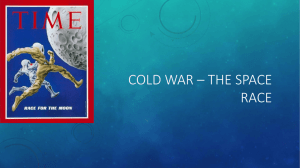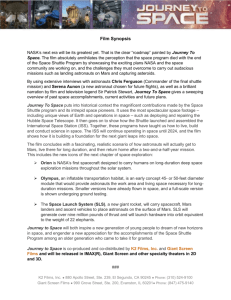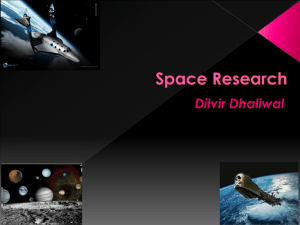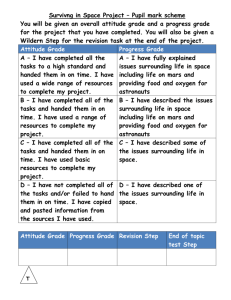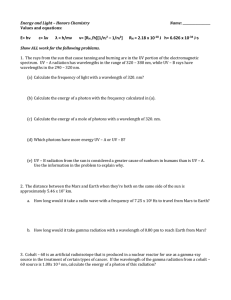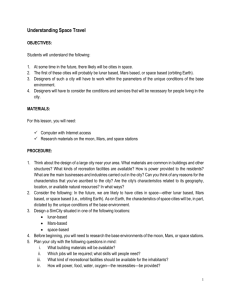Paper #3-SPACE EXPLORATION
advertisement
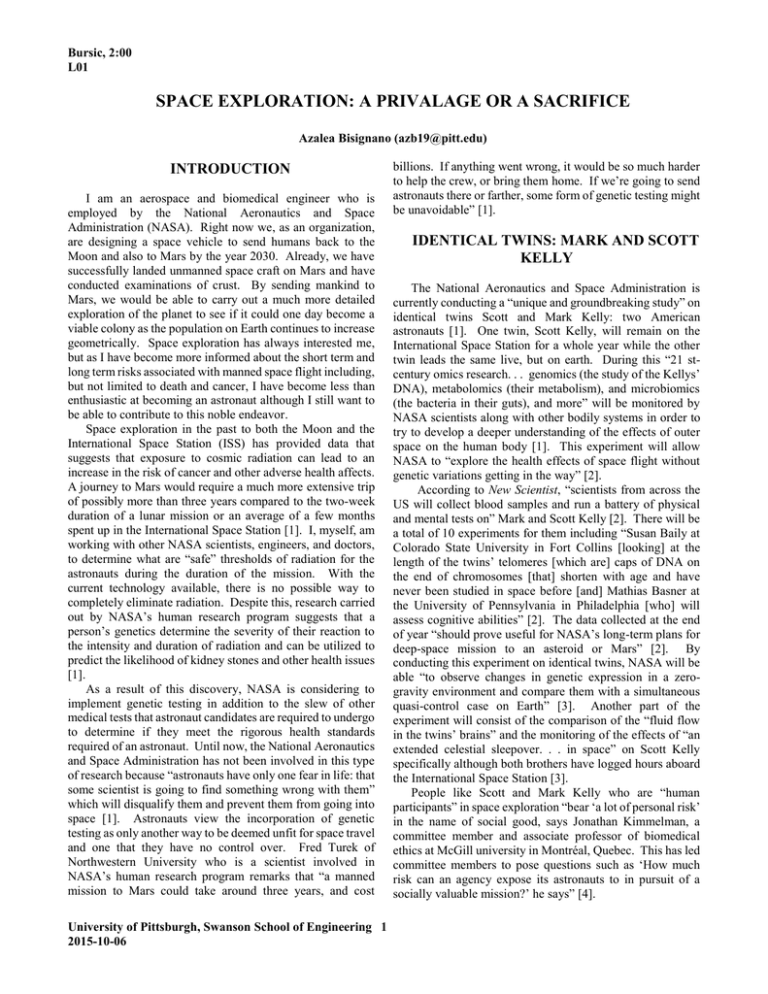
Bursic, 2:00 L01 SPACE EXPLORATION: A PRIVALAGE OR A SACRIFICE Azalea Bisignano (azb19@pitt.edu) INTRODUCTION I am an aerospace and biomedical engineer who is employed by the National Aeronautics and Space Administration (NASA). Right now we, as an organization, are designing a space vehicle to send humans back to the Moon and also to Mars by the year 2030. Already, we have successfully landed unmanned space craft on Mars and have conducted examinations of crust. By sending mankind to Mars, we would be able to carry out a much more detailed exploration of the planet to see if it could one day become a viable colony as the population on Earth continues to increase geometrically. Space exploration has always interested me, but as I have become more informed about the short term and long term risks associated with manned space flight including, but not limited to death and cancer, I have become less than enthusiastic at becoming an astronaut although I still want to be able to contribute to this noble endeavor. Space exploration in the past to both the Moon and the International Space Station (ISS) has provided data that suggests that exposure to cosmic radiation can lead to an increase in the risk of cancer and other adverse health affects. A journey to Mars would require a much more extensive trip of possibly more than three years compared to the two-week duration of a lunar mission or an average of a few months spent up in the International Space Station [1]. I, myself, am working with other NASA scientists, engineers, and doctors, to determine what are “safe” thresholds of radiation for the astronauts during the duration of the mission. With the current technology available, there is no possible way to completely eliminate radiation. Despite this, research carried out by NASA’s human research program suggests that a person’s genetics determine the severity of their reaction to the intensity and duration of radiation and can be utilized to predict the likelihood of kidney stones and other health issues [1]. As a result of this discovery, NASA is considering to implement genetic testing in addition to the slew of other medical tests that astronaut candidates are required to undergo to determine if they meet the rigorous health standards required of an astronaut. Until now, the National Aeronautics and Space Administration has not been involved in this type of research because “astronauts have only one fear in life: that some scientist is going to find something wrong with them” which will disqualify them and prevent them from going into space [1]. Astronauts view the incorporation of genetic testing as only another way to be deemed unfit for space travel and one that they have no control over. Fred Turek of Northwestern University who is a scientist involved in NASA’s human research program remarks that “a manned mission to Mars could take around three years, and cost University of Pittsburgh, Swanson School of Engineering 1 2015-10-06 billions. If anything went wrong, it would be so much harder to help the crew, or bring them home. If we’re going to send astronauts there or farther, some form of genetic testing might be unavoidable” [1]. IDENTICAL TWINS: MARK AND SCOTT KELLY The National Aeronautics and Space Administration is currently conducting a “unique and groundbreaking study” on identical twins Scott and Mark Kelly: two American astronauts [1]. One twin, Scott Kelly, will remain on the International Space Station for a whole year while the other twin leads the same live, but on earth. During this “21 stcentury omics research. . . genomics (the study of the Kellys’ DNA), metabolomics (their metabolism), and microbiomics (the bacteria in their guts), and more” will be monitored by NASA scientists along with other bodily systems in order to try to develop a deeper understanding of the effects of outer space on the human body [1]. This experiment will allow NASA to “explore the health effects of space flight without genetic variations getting in the way” [2]. According to New Scientist, “scientists from across the US will collect blood samples and run a battery of physical and mental tests on” Mark and Scott Kelly [2]. There will be a total of 10 experiments for them including “Susan Baily at Colorado State University in Fort Collins [looking] at the length of the twins’ telomeres [which are] caps of DNA on the end of chromosomes [that] shorten with age and have never been studied in space before [and] Mathias Basner at the University of Pennsylvania in Philadelphia [who] will assess cognitive abilities” [2]. The data collected at the end of year “should prove useful for NASA’s long-term plans for deep-space mission to an asteroid or Mars” [2]. By conducting this experiment on identical twins, NASA will be able “to observe changes in genetic expression in a zerogravity environment and compare them with a simultaneous quasi-control case on Earth” [3]. Another part of the experiment will consist of the comparison of the “fluid flow in the twins’ brains” and the monitoring of the effects of “an extended celestial sleepover. . . in space” on Scott Kelly specifically although both brothers have logged hours aboard the International Space Station [3]. People like Scott and Mark Kelly who are “human participants” in space exploration “bear ‘a lot of personal risk’ in the name of social good, says Jonathan Kimmelman, a committee member and associate professor of biomedical ethics at McGill university in Montréal, Quebec. This has led committee members to pose questions such as ‘How much risk can an agency expose its astronauts to in pursuit of a socially valuable mission?’ he says” [4]. Azalea Bisignano which NASA was required to present to on May 30, 2014 “is not recommending specific numbers or risk levels concerning radiation exposure. . . it will provide NASA with some guiding principles [4]. According to NASA’s senior bioethicist Paul Root Wolpe, “NASA cannot say, ‘Well, if an astronaut volunteers to go beyond a set of safety standards, we should let them; it’s their free will’” [4]. As an employee of this government-sponsored organization, I agree that this stance is the correct and ethical one to take because if some astronaut decided to embark on a mission despite said mission having already been determined to be high risk and something tragic were to happen, we as engineers would be at fault. The first and therefore probably most important commandment of the American Institute of Aeronautics and Astronautics (AIAA) Code of Ethics is to “[h]old paramount the safety, health, and welfare of the public” [5]. By allowing an astronaut to knowingly put him or herself in a highly dangerous situation would be a direct violation of this directive because we as aerospace engineers would not be taking every precaution not to directly or indirectly put someone’s safety, health, and welfare at risk as a result of our actions. The National Society of Professional Engineers Code of Ethics for Engineers has many of the same or very similar Canons as those of the AIAA Code of Ethics. In fact, the first canon of the NSPE Code of Ethics for Engineers is exactly the same as that of the AIAA Code of Ethics, thereby just further highlighting the importance to “old paramount the safety, health, and welfare of the public” [6]. POTENTIAL RISKS “Space exploration and clinical research involving human participants share many similarities” in the form of personal risks [4]. Radiation exposure poses a major concern for any space agency who is considering a deep space mission in their future “since leaving low earth orbit and travelling to Mars will raise a crew’s exposure to levels far exceeding current standards” [4]. This fact limits the astronauts who can be considered because experienced astronauts with a lot of flight time have already been exposed to high levels of radiation for long periods of time, thereby raising their chances of developing cancer. Not only are astronauts exposed to cosmic radiation while in space, but they are also exposed to additional radiation “from medical tests such as X-rays and flight training on jets” [4]. “According to data obtained from the Curiosity rover. . . to Mars” astronauts would be exposed to radiation as high or higher than the current lifetime limit during one round-trip mission to Mars alone [4]. Other risks that astronauts are exposed to automatically as a part of their profession include the degeneration of tissue, muscle mass, and bone density resulting from living in microgravity conditions for extended periods of time. Due to a Mars mission being longer than any other mission has been so far up to date, the negative effects of the lack of gravity will as a result become magnified. Micro-gravity can also affect an astronaut’s eyesight because the lack of gravity allows the body’s fluids to become more evenly dispersed throughout the body instead of being concentrated in the lower half of the body (legs and feet). This thereby causes more fluid to exist in the brain which exerts more pressure on the eyes than what would normally occur while on earth. The most serious risk of being an astronaut is death. The fuel required to launch humans and all of their necessary cargo through the Earth’s atmosphere and out of the influence of Earth’s gravity is highly combustible. Launch and reentry are the two most dangerous parts of any mission and when failure is most likely to occur. The Challenger tragedy is an example of something going wrong during the launch phase, causing the rocket and its crew to blow up while the Columbia disaster is an example of the shuttle and crew burning up during reentry because of a problem during launch when a piece of foam broke off the external tank and damaged the shuttle’s heat tiles. Heat tiles are necessary to protect the shuttle and its cargo (most importantly the crew) from the extreme heat during reentry through the Earth’s atmosphere. OSHA AND OCCUPATIONAL HEALTH OSHA stands for the Occupational Safety & Health Administration and is a part of the U.S. Department of Labor. Its mission is “[t]o foster, promote, and develop the welfare of the wage earners, job seekers, and retirees of the United States, improve working conditions; advance opportunities for profitable employment; and assure work-related benefits and rights” [7]. As another agency of the United States government, the National Aeronautics and Space Administration should adhere to the protocols and regulations that OSHA sets forth to protect the safety and health of American workers. Astronauts are certainly a part of the America work force and are in fact directly employed and paid by the American government. One such regulation dictates acceptable and safe radiation levels to be no greater than 10 mW./cm.2 for periods of 0.1-hour or more or 1 mW.hr./cm.2 during any 0.1-hour period [7]. Included in this radiation protection guide is a warning that “some parts of the human body (e.g., eyes, testicles) may be harmed if exposed to incident radiation levels significantly in excess of the recommended levels” [7]. With the current technological advances, a mission to Mars would expose the astronauts to far greater amounts of radiation that what is considered “safe” by the Occupational Safety & Health Administration and therefore significantly increase the possibility of damage to THE ETHICS COMMITTEE ON ETHICS The National Aeronautics and Space Administration is required to make a presentation to an ethics committee before commencing on any mission. A mission to Mars presents more controversial issues than any of the missions undertaken prior to now due to its very nature of being a long duration/deep space mission. Although the ethics committee 2 Azalea Bisignano the human body as a result of the incredibly high levels of cosmic radiation. One case study titled “Occupational Health” was especially helpful in my final decision to not be involved in the development of a manned space craft designed for a Mars mission until better technologies are developed to shield astronauts from harmful cosmic radiation. This case study focused on the development of of respiratory problems among workers “exposed to hot metals eight ours a day, five days a week” which was noticed by a chemical engineer who acted as their supervisor [8]. The chemical engineer’s concern for his workers’ health and safety caused him to look further into the situation. He discovered that the workplace was “in full compliance with OSHA guidelines [which] do not apply to chemicals that have not been tested” [8]. Many of the chemicals that his workers were exposed to within the workplace fall in to the later category so therefore, there is no documentation on their effects on the human body. Relating this case study to my involvement in designing a space craft to send humans to Mars, I feel a moral obligation as did the chemical engineer in the scenario, to look after the welfare of those working with or under me in an effort to ensure that my actions (engineering or otherwise) do not have negative implications for others. The case study regarding structural design errors to a famous landmark which meant that “large winds would cause [it] to topple and in the process kill thousands of innocent people” is another example where one engineer or a group of engineers’ actions may negatively impact just a few people or society as a whole [11]. Even if it a choice between your professional reputation or the safety of other people, the safety of other people should be paramount. While it would definitely be impressive to say that I had been involved in sending humans to Mars, the high risk nature of such an endeavor is not worth the reputational boost if miraculously everything went perfectly smoothly and the astronauts did not end up with serious health conditions as a result of the mission. sending people to Mars within the next few decades, would still put their health and safety at risk (at least until better radiation shielding technology is developed). The “Adoption of a Safe Component” case study solidified my decision from the angle of discussing levels of risk in relation to the development of a “strap” that would provide “therapy of a condition in the extremities” [10]. Genetic testing also should not be used in the astronaut selection process because it is discriminatory and violates the tenth directive of the AIAA Code of Ethics which focuses on the fair and respectful treatment of all colleagues and co-workers [5]. In ethical situations where people’s safety is at risk, I suggest that engineers should always make the decision that most takes into account the welfare of society and people. Even if this decision is not the more economical one, making this choice will leave you with a clear conscious and you cannot be blamed for anything that goes wrong in the future because you acted with moral and ethical integrity throughout your involvement both professionally and personally. REFERENCES [1] K. Lunau. “The Great Within.” Maclean’s. (online article). http://web.a.ebscohost.com/ehost/detail/detail?vid=12&sid= d62260b6-bd28-4a4c-858b05385e07b1c7%40sessionmgr4005&hid=4207&bdata=JnNp dGU9ZWhvc3QtbGl2ZQ%3d%3d#AN=98529507&db=aph [2] “First Twin Space Log.” New Scientist. (online article). http://web.a.ebscohost.com/ehost/detail/detail?vid=16&sid= 43e5c5e4-fb36-4dac-9d393c4bcbdf4938%40sessionmgr4005&hid=4207&bdata=JnNp dGU9ZWhvc3QtbGl2ZQ%3d%3d#AN=94919867&db=aph [3] A. Nordrum. “Nature vs. Nurture vs. NASA.” (2015, March). Scientific American. (online article). http://web.b.ebscohost.com/ehost/detail/detail?vid=6&sid=9 a76df84-4fbb-4de2-b1317805b40a113c%40sessionmgr115&hid=101&bdata=JnNpd GU9ZWhvc3QtbGl2ZQ%3d%3d#AN=101051662&db=aph [4] M. Shuchman. (2013). “Striving for Mars: What are acceptable risks?” Canadian Medical Association Journal. (online article). http://www.cmaj.ca/content/186/1/E7.full [5] “AIAA Code of Ethics.” The American Institute of Aeronautics and Astronautics (AIAA). (online article). https://www.aiaa.org/CodeOfEthics/ [6] “NSPE Code of Ethics for Engineers.” National Society of Professional Engineers. (online article). http://www.nspe.org/resources/ethics/code-ethics [7] “Nonionizing radiation.” Occupational Safety & Health Administration. (online article). https://www.osha.gov/pls/oshaweb/owadisp.show_document ?p_table=STANDARDS&p_id=9745 [8] M. Pritchard. (2006, August 23). “Occupational Health.” National Academy of Sciences. (online article). http://www.onlineethics.org/Resources/Cases/Health.aspx GENETIC TESTING (OMICS) While genetic testing may allow for astronauts to be chosen whom have “molecular attributes. . . that alter [their] risk profile prior to entering the space environment” and thereby make them less susceptible to DNA damage and the resulting cancer that can occur from exposure to high amounts of radiation, I believe that humans or even animals should be used as test subjects for space flight until more advanced technologies that provide better protection against cosmic radiation are invented [9]. Although these astronauts who happen to be genetically better suited for the extreme conditions of space, Omics based analysis is revolutionary realm of medicine. Even with proper interpretation of genomics, transcriptomics, proteomics, and metabolomics, nobody is completely unsusceptible to the effects of such high levels of radiation over such a long duration and therefore 3 Azalea Bisignano [9] M. Schmidt, T. Goodwin. (2013, June 27). “Personalized medicine in human space flight: using Omics based analyses to develop individualized countermeasures that enhance astronaut safety and performance.” Springerlink.com. http://download.springer.com/static/pdf/379/art%253A10.10 07%252Fs11306-013-05563.pdf?originUrl=http%3A%2F%2Flink.springer.com%2Farti cle%2F10.1007%2Fs11306-013-05563&token2=exp=1446429903~acl=%2Fstatic%2Fpdf%2F379 %2Fart%25253A10.1007%25252Fs11306-013-05563.pdf%3ForiginUrl%3Dhttp%253A%252F%252Flink.spring er.com%252Farticle%252F10.1007%252Fs11306-01305563*~hmac=358b9dff7608d90cb638b73c9162b9c7575581b10 e1690f28b3f69189ac1709c [10] R. Popp. “Adoption of a Safe Component.” Stanford. (online article). http://biodesign.stanford.edu/bdn/ethicscases/19safecompon ent.jsp [11] “The Cost of Integrity.” WebGURU: Guide for Undergraduate Research. (online article). http://www.webguru.neu.edu/professionalism/casestudies/cost-integrity ADDITIONAL SOURCES Advanced Space Academy’s Trainee Manual. U.S. Space & Rocket Center. (print book). Mach III Aviation Challenge’s Trainee Manual. U.S. Space & Rocket Center. (print book). ACKNOWLEDGEMENTS Thank you Emelyn Fuhrman, my writing instructor, for helping me through the process of writing this paper by providing me with advice and recommendations. Also thank you to all the crew trainers at Space Camp for basically teaching me all that I know about spaceflight. 4

